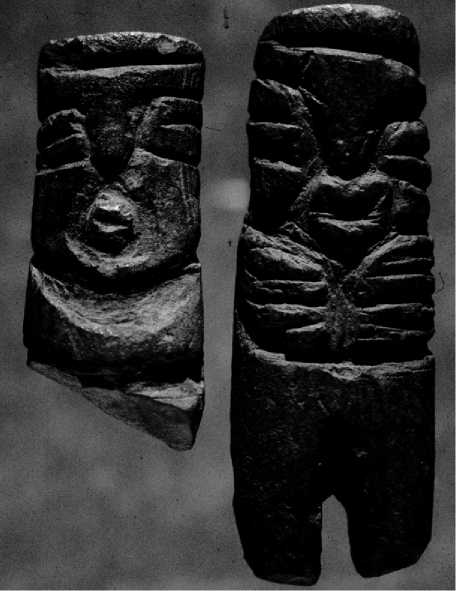In Ecuador, the Middle Holocene saw the establishment of permanent villages. Beginning around 5500 years ago, villages were established in the small tropical valleys of the southwestern corner of the country. Farmers also settled the floodplains of the Guayas Basin about that time. The northern lowlands of Ecuador may have experienced similar settlement, but that evidence, if there was any, was buried several millenniums ago by layers of volcanic ash strewn over the region from eruptions in the Andes.
These earliest recorded villages ranged in size from 2 to 12 ha in area. They were commonly situated on
.j: L: L: l
>n~-r"' '
•¦ T'""

Figure 5 Valdivia stone figurines from the Loma Alta site, Ecuador. Thousands of these figurines have been recovered from early Valdivia sites. (Photo by Gerald Newlands)
Figure 4 Sherds from the rims of early Valdivia ceramic bowls, Loma Alta site, Ecuador. (Photo by Gerald Newlands)
Low hills. Like the Colombian site of Puerto Hormiga noted above, the settlements were arranged in an oval pattern, with huts distributed around a cleared central arena. In some instances, there was a break at one end of the oval, giving the settlement a horseshoe shape. Well-made ceramics of the Valdivia style occur in abundance at each of the sites. Again, like the Puerto Hormiga ceramics, a high percentage was decorated, suggesting that ceramic vessels played an important social role (Figure 4). For the first time in the archaeological record of South America, figurines, made of stone and slightly later of ceramic, also occur and in large numbers (Figure 5). Some were found in probable ritual contexts, but the majority come from domestic trash heaps, suggesting that they were mainly used in household rituals that occurred with some frequency.
Judging by the varied locations of the sites, a variety of resources was exploited, but all of the village settlements are associated with rich valley bottom land, signaling a common reliance on agricultural produce. The warm wet conditions have not been conducive to the preservation of plant remains, but microscopic botanical remains have been recovered from the floors of the houses, from storage pits, from food-grinding tools and residues of pottery, indicating that maize, manioc, arrowroot, beans, and other tropical staples were being farmed. Those living in the interior parts of the valleys probably relied mainly on hunted game such as deer or peccary for their meat, while those living near the ocean ate more seafood. The presence of shells and fish bones at the interior sites, however, attests to the transport of some seafood inland, and it seems likely that commodities were being exchanged between communities up and down valley.
Between 5000 and 4000 years ago, hierarchies emerged among sites within and between valleys. At some of the larger sites, for example, Real Alto, the central arena became a ceremonial precinct. Small mounds and other ceremonial facilities were constructed within the central plazas. Among the rituals conducted were funerary rites. Some individuals were still buried beneath house floors, but there was also community-wide veneration of some of the dead, who were buried in a funerary mound. Satellite hamlets have been discovered and were probably connected through a social network to the ceremonial centers. The relative size and patterned distributions of houses within the larger settlements suggest the existence of status differences associated with kinship and residence (see Social Inequality, Development of; Spatial Analysis Within Households and Sites).
Over the next two millenniums, there was a steady increase in population size and density throughout most of the western Ecuadorian lowlands. Efficient agricultural systems were established; craft specialization developed, and intraregional exchange expanded, as well as long-distance trade with populations in the highlands and along the coast. Prestige goods, including spondylus shells and obsidian, were among the goods traded over long distances. Monumental earthen mounds associated with fancy pottery hint at the rise of an elite class. Unfortunately, archaeology has only begun to explore the remains of these hierarchical societies, so we can only guess at their size and structure.
The pace of change toward sedentary villages in Panama seems to have been slightly slower than that in Ecuador. Monagrillo, which replaced Cerro Mangote around 2500 BCE, is the only possible candidate for a sedentary village. Covering an area of 1.4 ha, it is 8 times the size of Cerro Mangote. Fishing nets were in use, enabling the fishermen to catch a range of fish species that were inaccessible to the Cerro Mangote residents. The presence of pottery suggests a degree of sedentism, but in contrast to the San Jacinto and Valdivia pottery, Monagrillo pottery was poorly fired and plain - clearly pottery played a different social and symbolic role in Panama at this time than it did in northern Colombia or western Ecuador. The sites in the hills continued to exhibit a pattern of small, temporary settlements, probably associated with the expansion of slash-and-burn agriculture. It was not until 500 BCE that settlement in the river valleys is evident, and then, based on research in the Santa Maria Valley, suddenly large sedentary villages were established, associated with well-made pottery and containing abundant carbonized remains of maize. The suddenness of the change may be more apparent than real, in that earlier, smaller settlements in the Santa Maria Valley may as yet lie undiscovered under the alluvial bottomlands.




 World History
World History









